7 Best Generative Engine Optimization Tools to Win in AI Search
- by Ilona K.

Table of contents
AI search is moving fast. Some days it feels like it’s changing quicker than refreshing your browser. And as AI-powered platforms like ChatGPT, Perplexity, and Google’s AI Mode and AI Overviews grab more user attention, they’re also shifting how people discover businesses online. Instead of pointing users to a list of links, these models often summarize the internet for them – and that means your content gets seen only if the model understands it well enough to include it.
That’s where generative engine optimization (GEO) comes in. Think of it as providing AI models with a clearer picture of who you are, what you do and why your website deserves a mention. This guide breaks down the best GEO tools right now, what they actually help with, what they cost and the kind of business each one fits.
Why GEO Matters Right Now
GEO sits somewhere between SEO and online branding. Instead of only optimizing for search engines, you’re fine-tuning your content for AI systems that access your website. Industry discussions around Generative Engine Optimization (GEO) show how this shift is changing digital visibility, and Wired’s piece on GEO dives into why AI-first brand presence is becoming a real competitive advantage.

Source: Unsplash
In the times when the websites are adjusting to Google AI Mode and brands are learning how to optimize for ChatGPT search, no specialist can navigate those choppy waters alone. So we’ve put together some guidance, and a set of handy tools to get started with GEO for your business, no matter its size.
The Best GEO Tools at a Glance
Before diving into the details, here’s a quick table to help you see how these tools compare. Each of those tools tie into many Generative Engine Optimization strategies discussed in the industry – but the choice ultimately depends on your business goals and budget.
| Tool | What it does well | Business size | U.S. pricing | Best use case |
| Profound | Reads how AI models “see” your brand | Mid-size to enterprise | From ~$99/month; realistically for large businesses on par with Brandlight | Brands needing broad AI visibility |
| Semrush AI Toolkit | Combines SEO + GEO in one place | Small to large | $99/month add-on; requires Semrush subscription | Teams already using Semrush |
| Writesonic | Content creation + GEO scoring | SMBs & publishers | $39–$199/month | Blogs and content-heavy sites |
| Amplitude AI Visibility | Connects AI visibility with analytics | SaaS & product-led | Free options; paid plans from ~$49/month | Understanding AI-driven conversions |
| Brandlight | Deep brand representation tracking | Enterprise | From $4k/month | Multi-market brands |
| Peec AI | Clear prompt tracking | SMBs | From EUR 89/month | Simple GEO insights without complexity |
| AthenaHQ | Advanced GEO testing across models | Growth-stage brands | From $295/month | Scaled prompt testing and GEO audits |
A Closer Look at Each AI Search Optimization Tool
1. Profound
Profound focuses on one big question: How do AI models talk about your brand? It shows how systems like Google Gemini, ChatGPT, Claude and Perplexity summarise your website, which details they get right and what they completely miss. For businesses with lots of products or services, this kind of visibility can be surprisingly eye-opening.
Some of the most promising features Profound offers include:
- Prompts volume – helps understand exactly how often a certain type of prompt is entered by users;
- Query fan-out – explains how the long detailed prompts are ‘translated’ by LLMs into more familiar keywords
- Data on Reddit – in collaboration with the platform, Profound shows how the Q&A’s feed into AI search responses.
Good for: the most comprehensive AI reputation view.
Cons: high pricing might be a barrier for those who just start experimenting with GEO.
Pricing: from $99/month; $399/month for lighter tiers; enterprise plans go much higher.
Perfect fit for: large e-commerce sites – especially those using domains like shop.it.com – where product clarity matters.
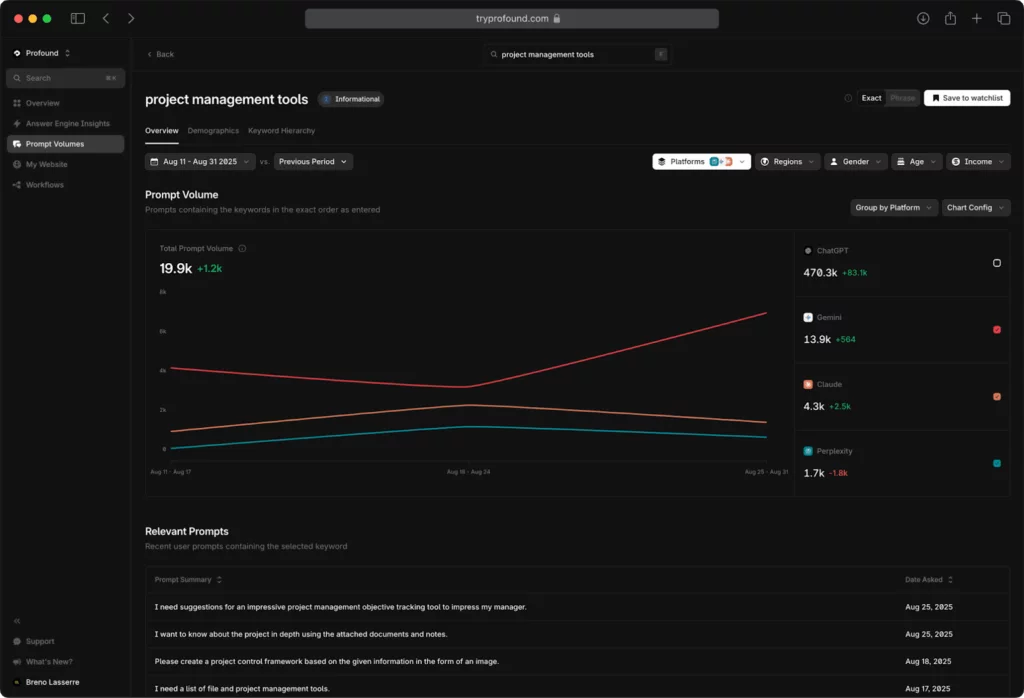
2. Semrush AI Toolkit
If your team already uses Semrush for SEO (search engine optimization), this AI toolkit fits right in without much fuss. It extends the platform’s SEO tools into GEO, which is nice if you want everything in one place instead of juggling multiple dashboards.
Some useful features include:
- Prompts research for your brand or industry
- Key narrative drivers – the topics that shape your AI search presence
- Strategic guidance – prioritised actions to improve GEO visibility
Good for: blending SEO with AI search strategies.
Cons: limited functionality with a focus on basics; requires Semrush subscription.
Pricing: $99/month add-on for AI Toolkit, plus Semrush base plan starting at $139.95/month.
Perfect fit for: businesses who want GEO insights without switching platforms.
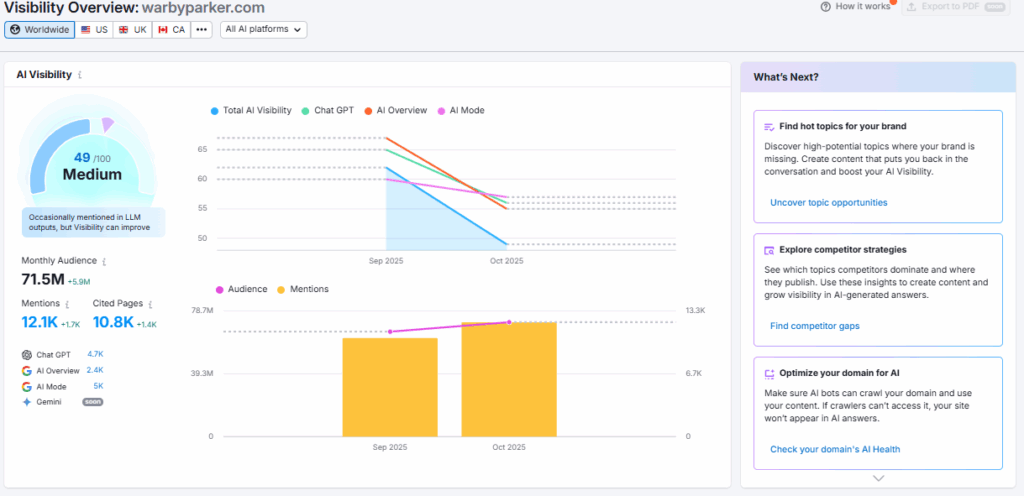
3. Writesonic
Writesonic mixes content creation with practical GEO scoring. It evaluates how likely your content is to show up in AI-generated answers and recommends improvements. This feels especially helpful for businesses publishing blogs, guides or tutorials – and for the non-ecommerce businesses which depend on content for their online performance. Features worth noting include:
- AI Search volume explorer to understand what users actually ask AI
- Content writer, adapted for LLM requirements
- Scaled AI-powered content strategy creation
Good for: AI-first content strategies and content creation.
Cons: limited data pool vs Profound; less useful for e-commerce sites due to less focus on products than on content.
Pricing: $39–$199/month depending on the plan.
Perfect fit for: small businesses and content resources that depend on steady optimized content to grow visibility.
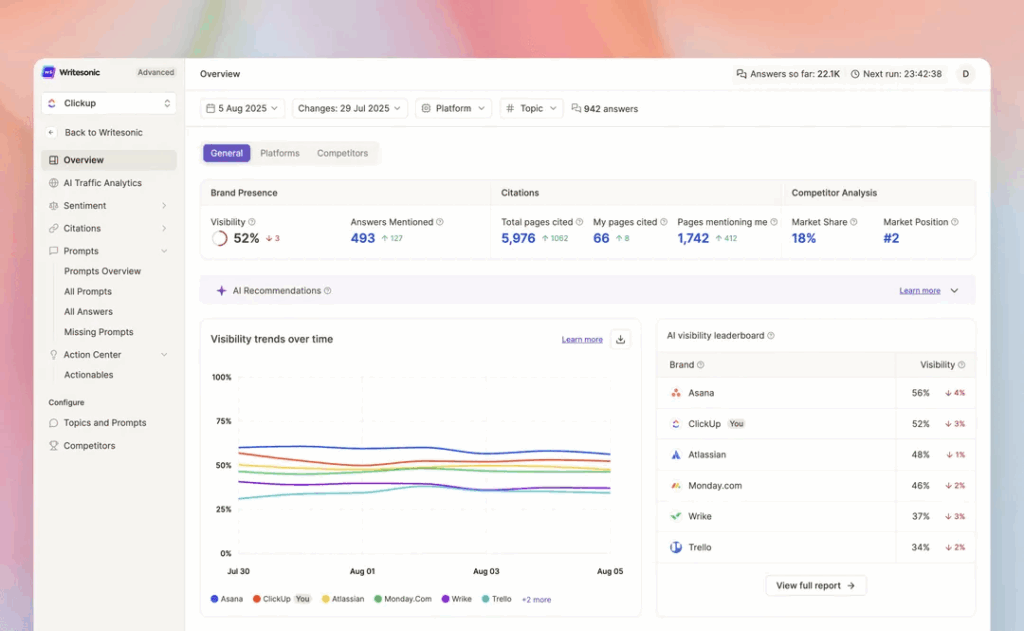
4. Amplitude — AI Visibility
Amplitude adds an important layer to GEO: it shows how AI-driven visibility affects actual user behaviour. If you’re running an IT business, understanding how AI-generated answers feed your customer acquisition funnel is genuinely useful – and with Amplitude, you can start doing it for free.
In this tool, you can research:
- A matrix of competitor topics – where your competitors are winning
- Prompts relevant to your website
- Sources most often cited in relation to your business and industry
Good for: a quick free snapshot for the starters; analysis of user behavior in the long-term.
Cons: free options are limited and slower; lack of deep-dive data.
Pricing: Free option; in-depth analytics plans available from $49/month.
Perfect fit for: smaller IT businesses with a domain like platform.it.com that want to map AI influence to conversions.
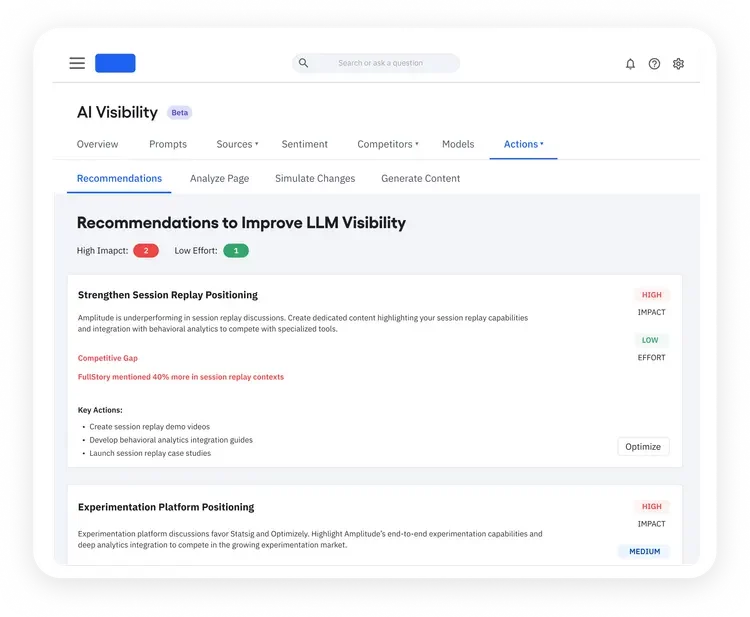
5. Brandlight
Brandlight digs deep into how AI models summarise your business – especially across multiple countries or markets. It’s a heavyweight platform designed for large companies, not casual users. Some of the prominent features of the platform include:
- Visibility for all relevant prompts for your business – not only the ones you’ve input
- Detailed action plan allowing to jump straight into the optimization
- Variety of LLMs available on the platforms.
Good for: enterprises with big brand footprints.
Cons: relatively high pricing creates a barrier for smaller businesses.
Pricing: typically from $4,000, depending on scale.
Perfect fit for: global franchises with multiple subdomains, such as brand.it.com.
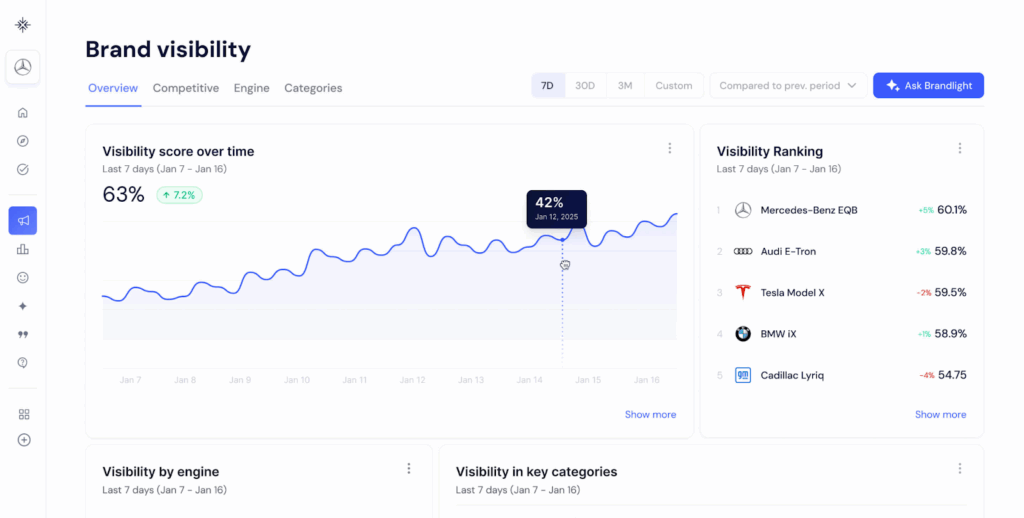
6. Peec AI
Peec AI keeps things simple and very clear. It tracks which prompts trigger your brand, how often you appear in AI answers and what those answers look like. It’s straightforward enough for smaller teams that don’t want to drown in charts.
While the tool doesn’t have any unique standout features that don’t exist in other platforms, the clarity and focused view (with actionable insights) might be appealing to SMBs making their first steps in GEO.
Good for: Small and medium-sized businesses that want quick GEO clarity.
Cons: top-level insights without a deep dive.
Pricing: Starts at EUR 89/month, goes up based on prompts and usage.
Perfect fit for: service businesses with domains like services.it.com that want GEO insights without enterprise costs.

7. AthenaHQ
AthenaHQ is built for businesses that want to test a lot of prompts across several AI models – and do it consistently. It gives detailed visibility into model behaviour and offers GEO content briefs based on what it finds. Among the notable features are:
- Revenue attribution from AI search to understand how AI Search drives sales
- Custom recommendations per specific verticals
- Integration with Shopify
Good for: brands scaling their GEO efforts.
Cons: relatively high entry cost
Pricing: from $295/month for 3,500 credits, with higher tiers available.
Perfect fit for: online marketplaces using domains like market.it.com where a lot of content needs to stay model-friendly.

How to Pick the Right Tool (Without Overthinking It)
Here’s a quick way to narrow it down:
- Writing lots of content? → Writesonic or Peec AI
- Already deep into SEO? → Semrush AI Toolkit
- Want analytics plus GEO? → Amplitude
- Need big-picture AI visibility? → Profound or Brandlight
- Running a fast-growing business with lots of prompts to test? → AthenaHQ
Budget also plays a role. Some tools are priced for smaller businesses; others are clearly meant for enterprise budgets with scaled needs. And if you’re planning a broader AI takeover, the guide on AI tools to plan a digital strategy is a good companion.
GEO isn’t just another marketing buzzword. It’s becoming a practical way to stay visible in AI-driven search experiences. With the right tool, you can understand how models talk about your brand, fix misunderstandings and make sure your content stands a fair chance of being included in AI answers – not left behind in the digital background noise.
FAQs
What is Generative Engine Optimization?
GEO helps AI systems understand your content and mention your brand when users ask questions. It focuses on clarity, structure and model-friendly writing.
How to do GEO SEO?
You improve how models interpret your site by cleaning up your content, testing prompts, updating structure and using GEO tools to track progress.
What is GEO in LLMs?
It’s the practice of making your site easier for large language models to interpret so they’re more likely to reference it in generated answers.
How do I do GEO for my website?
Start by checking how AI models currently summarise your site, fix unclear sections, test a few prompts and track your visibility with a GEO audit tool.
What are the best generative engine optimization tools in 2025?
There are strong choices including Profound, Semrush AI Toolkit, Writesonic, Amplitude, Brandlight, Peec AI and AthenaHQ. Each one suits a different type of business.

Read also

Tips and Tricks
AI Appreciation Day: Top-10 Domain Names for AI Startups on it.com Domains
- 3 min read

